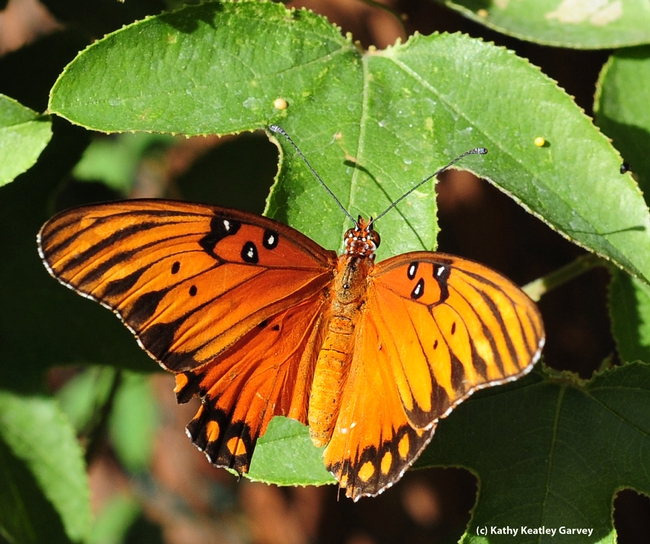- Author: Kathy Keatley Garvey
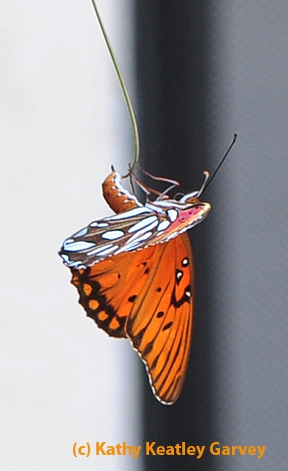
Complete metamorphosis. Complete awe.
In our yard, the Gulf Fritillary butterflies (Agraulis vanillae) are laying eggs on our passionflower vine (Passiflora). They deposit the eggs on top of the leaves, beneath the leaves, or on the tendrils.
An egg hatches, and a caterpillar--a very hungry caterpillar--emerges. It eats as if there is no tomorrow, and for some, there IS no tomorrow. Predators, including birds, spiders, praying mantids and European paper wasps, await them.
Humans also kill them with pesticides because the caterpillars do what they're supposed to do--eat the leaves. Skeletonized plants in the garden? Horrors, what would our neighbors say?
But, if all goes well, and the caterpillars thrive, the next stage is the chrysalis.
Finally, the adult butterfly emerges from the chrysalis to start the life cycle all over again.
Sometimes when you look at the tiny yellow Gulf Frit egg, it's difficult to imagine that one day it will become a reddish-orange butterfly fluttering around the garden, sipping nectar from lantana (genus Lantana), Mexican sunflowers (Tithonia) and other plants.
Interested in butterflies? When you get a chance, you should explore Art Shapiro's Butterfly World. Shapiro, a distinguished professor of evolution and ecology at the University of California, Davis, monitors the butterfly population in the Central Valley. He's also written a book, Field Guide to Butterflies of the San Francisco Bay and Sacramento Valley Regions.
And those amazing Gulf Frits? They're making a comeback in the Sacramento area.
And none too soon.
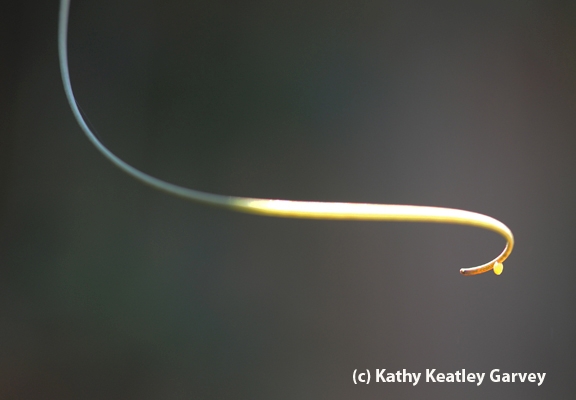

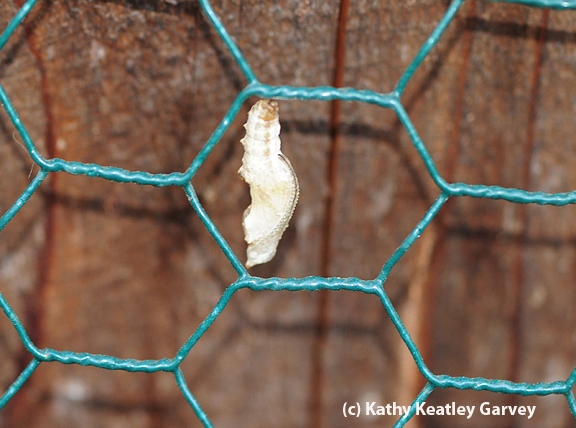

- Author: Kathy Keatley Garvey
At last! From an egg to a caterpillar to a chrysalis to a butterfly.
And it's a girl!
For several days we've been protecting a Gulf Fritillary (Agraulis vanillae) chryalis on our passionflower vine (Passiflora) from predators.
It works like this: Adult female butterflies lay their eggs on the plant, and predators prey upon the eggs, caterpillars and chrysalides. Result: eggs gone, caterpillars gone, and chrysalides smashed open and the contents (our future butterflies) removed.
So we clipped a white cotton dishtowel around the chrysalis to prevent predation from jumping spiders, orb weavers, ants, praying mantids, European paper wasps and assorted scrub jays.
Sunday morning it happened.
A female butterfly emerged from a chrysalis. She remained close to the chrysalis before moving outside the apiary wire (the wire is stapled to a fence to support the clingy passionflower vine).
Not two minutes later, as "our girl" was drying her wings, getting ready for her first flight, a suitor approached her.
The rest, as they say, is history.
And more Gulf Fritillary butterflies.
We hope.





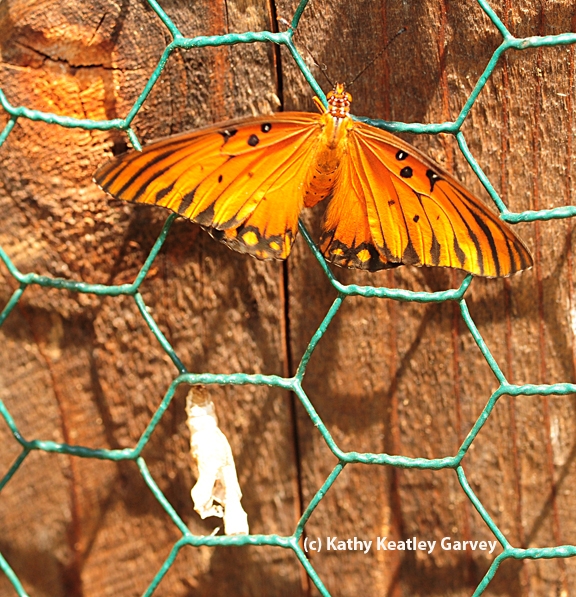
- Author: Kathy Keatley Garvey
For months, I've been waiting ah, so patiently (well, not always s-o-o-o patiently) for the gulf fritillary butterfly to touch down on our Mexican sunflower, Tithonia.
A perfect match, I figured. The showy reddish-orange butterfly (Agraulis vanillae) sipping nectar from the equally orange and showy Mexican sunflower.
No such luck. Every time I'd check the yard for the special butterfly-blossom scenario, it was always landing on something else: multi-colored lantana, lavender lantana, and the passion flower vine (genus Passiflora).
And occasionally, a pomegranate tree or tomato plant.
Oh, sure, it did visit the Tithonia, but it would vanish before I could grab the camera.
However, on Sunday, following the San Francisco Giants' game, I was thinking orange. Bright orange. Baseball orange. I stepped outside, and voila!
Touchdown! The perfect match!
The butterfly lingered long enough for me to capture its image, a side view of its silver-spangled wings, as well as a bird's eye view (Please, scrub jays, don't eat my butterfly.) It then fluttered off to the passion flower vine.
The gulf flit was once prevalent in the Sacramento area in the 1960s, but "it seems to have died out by the early 1970s," according to butterfly expert Art Shapiro, professor of evolution and ecology at the University of California, Davis.
It's been making a comeback in the Sacramento area since 2009.
Sunday was a perfect comeback day. And a perfect touchdown day!



- Author: Kathy Keatley Garvey
'Twas the night before Christmas, when all through the house
Not a creature was stirring, not even a mouse...
--Clement Clarke Moore (1779-1863)
In our house, nothing is stirring, thanks be to the cat. Xena the Warrior Princess does not like anything stirring. Even the dog annoys here.
But in the yard, quite a few insects were stirring on the Passiflora (passion flower vine) this afternoon. We planted it last summer to attract Gulf Fritillary butterflies (Agraulis vanillae). Passiflora is their host plant. In the late summer, we saw the adults mating and an occasional female laying eggs. Then the caterpillars appeared and began munching on the leaves.
Today we spotted about eight Gulf Fritillary caterpillars soaking up what was left of the sun. Also on board was a Gulf Fritillary chrysalis, but it was not stirring.
An overwintering Harlequin bug wandered around looking lost--but we're sure it was up to something. Last summer its ancestors were enjoying our lemon cucumbers, planted nearby.
As butterfly expert Art Shapiro, distinguished professor of evolution and ecology at UC Davis says about the Harlequin bugs: "They prefer Crucifers (cabbage, cauliflower, broccoli, kale, etc.) but are not limited to 'em!"

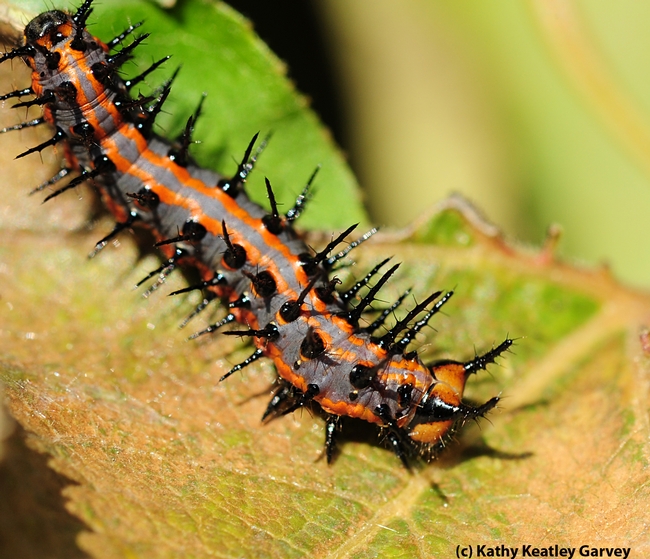

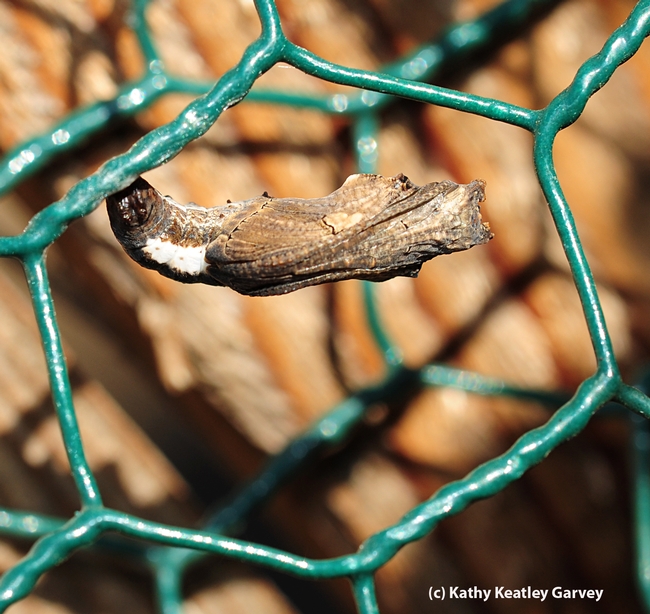
- Author: Kathy Keatley Garvey
Whew! That was close!
When you see a butterfly with a gaping hole in its wingspan, you wonder what predator tried to grab it. A praying mantis? A bird? A crab spider or jumping spider? A playful cat or dog?
Whatever tried to grab it, it missed.
That brings to mind the proverbial saying, "A miss is as good as a mile," dating back to the 18th century. It first appeared in The American Museum, Volume 3, 1788.
The author wasn't talking about a Gulf Fritillary (Agraulis vanillae) missing a chunk of its wing, but the meaning is the same: a miss, whether as narrow as a strand of hair or as wide as the AT&T ballpark (where the San Francisco Giants clinched their National League championship tonight!), is still a miss.
This particular Gulf Fritillary landed on its host plant, a passion flower vine (Passiflora) last Sunday and then fluttered off, only to be replaced by scores of others. They were laying eggs on the plant.
One Gulf Frit touched down on the bright red blossom of the triangular-leafed Passiflora manicata, variety Linda Escobar. Its wingspan? Perfect.
It may not be tomorrow, though.
